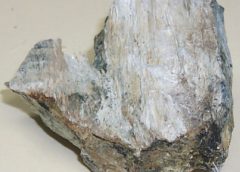The Rock No One Thought Would Make a Comeback Could Be Making a Comeback.
By Megan Caldwell, Partner, Husch Blackwell
Asbestos rock was last mined in the United States in 2002, and arguably for good reason: inhalation of asbestos fibers has been linked to a number of serious health problems and respiratory diseases, and some estimates point to as many as 40,000 Americans dying annually due to exposure to the known carcinogen in occupational and residential settings.
Nonetheless, it is possible we may see a resurgence of asbestos mines in the United States and worldwide in the not-so-distant future, thanks to a recent rule proposed by the Trump Administration. On June 1, the United States Environmental Protection Agency (EPA) proposed a Significant New Use Rule (SNUR) for asbestos, which would allow the government to evaluate new uses of asbestos on a case-by-case basis.
Asbestos is a generic term used to describe hydrated magnesium silicate minerals that crystallize as bundles of long, thin fibers found in six types of rocks located throughout the world. Asbestos has remarkable properties – high tensile strength, flexibility and resistance to heat, chemicals and electricity – that led to its widespread use in a number of commercial and residential applications, including fire-resistant tiles and insulation.
History
The first large-scale asbestos mine in the country opened its doors in 1894 in Georgia, and asbestos was mined domestically in North Carolina, Virginia, Maryland, Pennsylvania, Connecticut and Massachusetts, with at least 60 mines operating in the Eastern United States over the years.
All that changed as discoveries of the health impacts emerged. The asbestos industry faced 3.3 million claims from asbestos victims between 1988 and 2010, resulting in payouts of $17.5 billion and the bankruptcy of more than 100 asbestos companies. More than 60 countries have enacted outright bans on the use of asbestos.
Although asbestos’s use in the United States is heavily restricted and the material is no longer used in construction, the country still allows limited use in products including gaskets, roofing materials and sealants. The EPA attempted to implement a sweeping ban of the substance in 1989, but the asbestos industry successfully defeated the effort in court.
International Production
Nonetheless, today, asbestos production is still active in a handful of countries, with Russia, China, Brazil, Kazakhstan and India serving as primary producers. China, the world’s leading asbestos consumer, reportedly used 570,006 metric tons of asbestos in 2013, and Russia is a close second, so there is still a demand for the material despite its clear health concerns.
A 2017 study by the Asbestos Disease Awareness Organization and the Environmental Working Group indicated that the United States imported an estimated 705 metric tons of asbestos in 2016. That domestic demand may grow with the new EPA rule in place. It is not entirely impossible that the United States and other countries may re-join the ranks of asbestos miners and producers in the near future.
So how did we get here? Under an Obama-era amendment to the Toxic Substances Control Act (TSCA) – called the Frank R. Lautenberg Chemical Safety for the 21st Century Act – the EPA is required to re-evaluate the safety of hundreds of potentially dangerous chemicals. Asbestos was named in the first group of 10 chemicals the EPA was to examine prior to the end of 2019.
On June 1 of this year, the EPA released documents refining the scope of the risk evaluations it plans to conduct for the first batch of 10 chemicals, asbestos included. Simultaneously, the EPA issued its SNUR for asbestos, allowing manufacturers and importers to ask the EPA to perform an evaluation regarding whether those businesses can start or resume manufacturing, importing, or processing of asbestos.
Significant New Use
The EPA can then issue an approval for a “significant new use” of asbestos, or alternatively, can seek to prohibit or limit the use. The SNUR therefore creates a new process for regulating uses of asbestos, something EPA is obliged to do under the TSCA amendment.
The effect of the new rule is up for debate. The SNUR on its face seems to implement more regulation of asbestos, but it may have a very different impact in practice. Andrew R. Wheeler, EPA’s acting administrator following Scott Pruitt’s resignation, has stated that the SNUR would make it more difficult to use asbestos in products and that EPA is in fact trying to strengthen oversight of asbestos, not gut it.
However, the wording of the new rule may instead make it easier to use asbestos, as it appears to allow for the reintroduction of the use of asbestos into new building materials. The Internet has erupted in a firestorm of criticism over the new rule and chatter about President Trump’s ties to asbestos-producing Russia. The public comment period on the new rule ended August 10, and there is little question that lawsuits are on the horizon to halt the SNUR from going into effect.
For now, though, the question remains: Is asbestos poised to make a comeback?
Megan Caldwell is an environmental attorney in the Denver, office of Husch Blackwell. She can be reached at Megan.Caldwell@huschblackwell.com.

